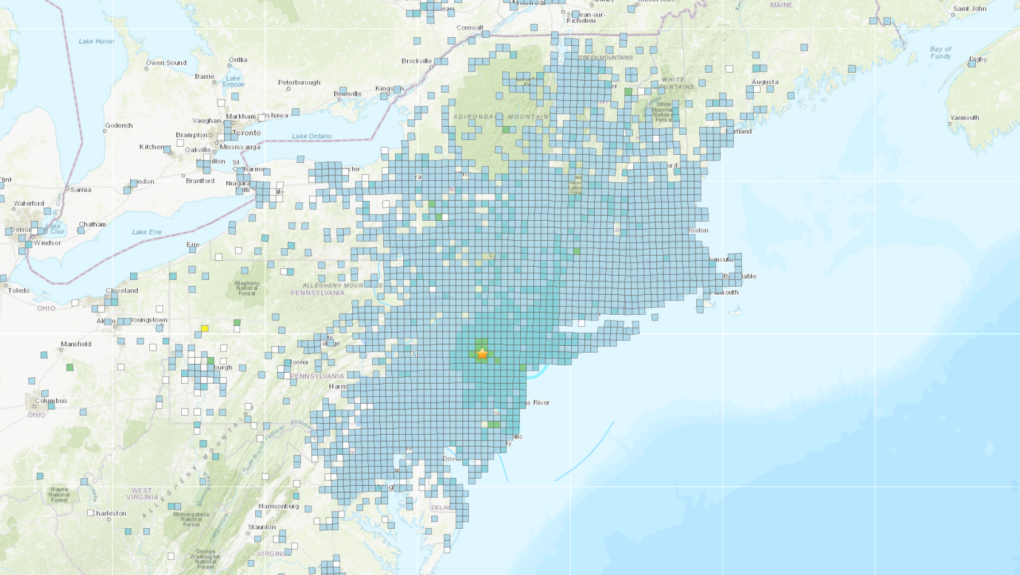Did you feel it? New York earthquake reaches Ontario
As an earthquake shook New York City on Friday morning, some Ontario residents felt rumblings.
Around 10:25 a.m., Harsim Randhawa was on the seventh floor of an office building in Waterloo, Ont. “I felt the building vibrate,” he said.
It was a small shake, but he felt it, and messaged others to spread the news. “They said people are probably moving stuff somewhere in the building,”Randhawa said.
- Download our app to get local alerts on your device
- Get the latest local updates right to your inbox
Ten minutes later, news broke of an earthquake in New York, with a preliminary magnitude of 4.8 at its centre.
It wasn’t just Randhawa who felt the rumble. Around the same time, Diane Thibault said she was sitting in an office chair in Hamilton’s east end when she felt it rock side to side as her desk lamp shook for less than a minute.
“It was a little jarring, to say the least,” Thibault said.
Along with Randhawa and Thibault, hundreds of submissions poured into the United States Geological Survey’s (USGC) “Did you feel it?” map, which pools community data based on where people noticed the earthquake. In Canada, reports were filed in Toronto, Niagara, Hamilton, Kitchener, Belleville, Ottawa and Montreal.
Michal Kolaj, a seismologist with Natural Resources Canada, said it’s “certainly possible” people in Toronto felt the quake. “It would have been [a] very weak shaking,” he added.
Kolaj explained earthquakes in eastern North America travel farther distances than in the west.
 The United States Geological Survey’s (USGC) “Did you feel it?” map, which pools community data based on where people noticed the earthquake, on April 5, 2024.
The United States Geological Survey’s (USGC) “Did you feel it?” map, which pools community data based on where people noticed the earthquake, on April 5, 2024.
That’s a result of the geology in eastern North America, which is older, denser and has had more time to heal, allowing seismic waves to travel further distances. In the west, where the bedrock is younger and more fractured, it absorbs more of the seismic energy.
According to USGC, eastern earthquakes are more of a mystery than in the west, because they don’t take place at a plate boundary. In contrast, eastern Canada is part of the stable interior of the North American Plate.
With the earthquake mere hours in the past, Kolaj said there’s still a possibility of aftershocks, but added that they would be smaller, and even less likely to be felt north of the border.
CTVNews.ca Top Stories

Donald Trump says he urged Wayne Gretzky to run for prime minister in Christmas visit
U.S. president-elect Donald Trump says he told Canadian hockey legend Wayne Gretzky he should run for prime minister during a Christmas visit but adds that the athlete declined interest in politics.
Historical mysteries solved by science in 2024
This year, scientists were able to pull back the curtain on mysteries surrounding figures across history, both known and unknown, to reveal more about their unique stories.
King Charles III focuses Christmas message on healthcare workers in year marked by royal illnesses
King Charles III used his annual Christmas message Wednesday to hail the selflessness of those who have cared for him and the Princess of Wales this year, after both were diagnosed with cancer.
Mother-daughter duo pursuing university dreams at the same time
For one University of Windsor student, what is typically a chance to gain independence from her parents has become a chance to spend more time with her biggest cheerleader — her mom.
Thousands without power on Christmas as winds, rain continue in B.C. coastal areas
Thousands of people in British Columbia are without power on Christmas Day as ongoing rainfall and strong winds collapse power lines, disrupt travel and toss around holiday decorations.
Ho! Ho! HOLY that's cold! Montreal boogie boarder in Santa suit hits St. Lawrence waters
Montreal body surfer Carlos Hebert-Plante boogie boards all year round, and donned a Santa Claus suit to hit the water on Christmas Day in -14 degree Celsius weather.
Canadian activist accuses Hong Kong of meddling, but is proud of reward for arrest
A Vancouver-based activist is accusing Hong Kong authorities of meddling in Canada’s internal affairs after police in the Chinese territory issued a warrant for his arrest.
New York taxi driver hits 6 pedestrians, 3 taken to hospital, police say
A taxicab hit six pedestrians in midtown Manhattan on Wednesday, police said, with three people — including a 9-year-old boy — transported to hospitals for their injuries.
Azerbaijani airliner crashes in Kazakhstan, killing 38 with 29 survivors, officials say
An Azerbaijani airliner with 67 people onboard crashed Wednesday near the Kazakhstani city of Aktau, killing 38 people and leaving 29 survivors, a Kazakh official said.

































